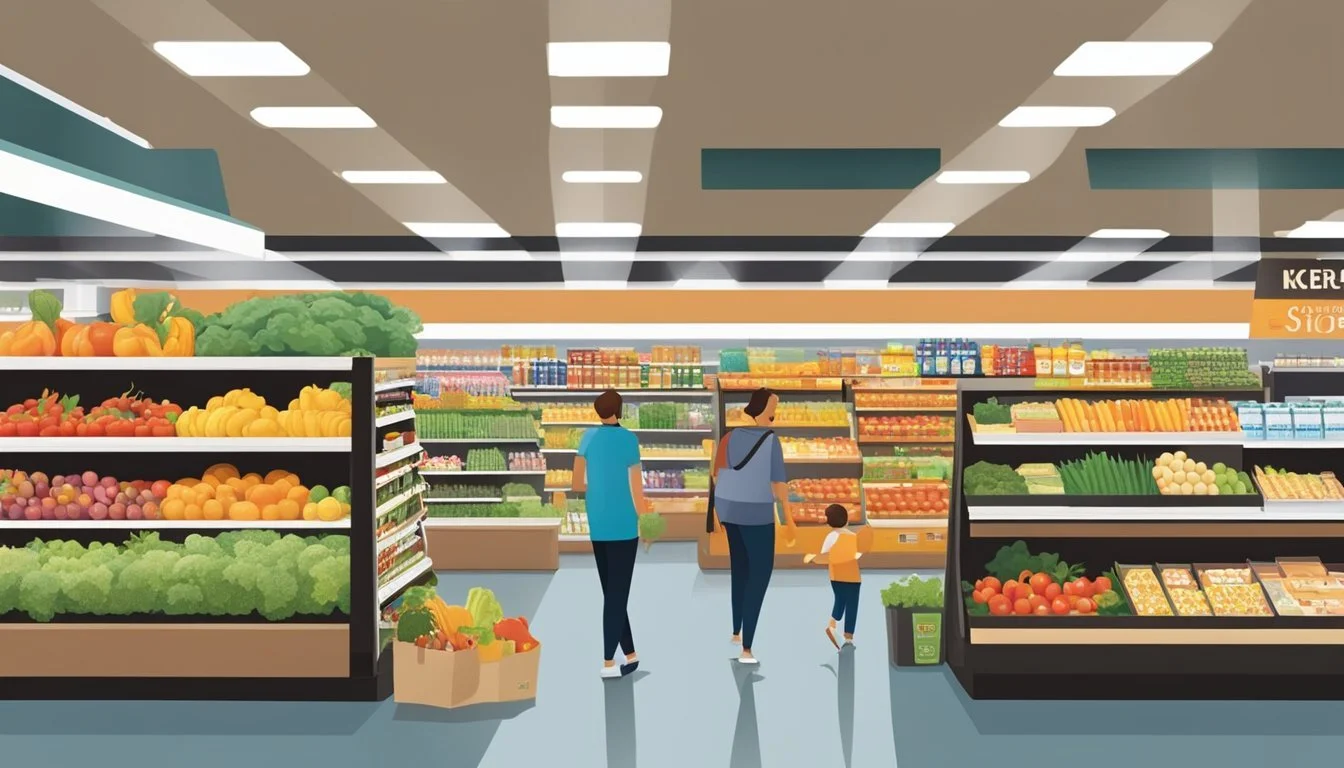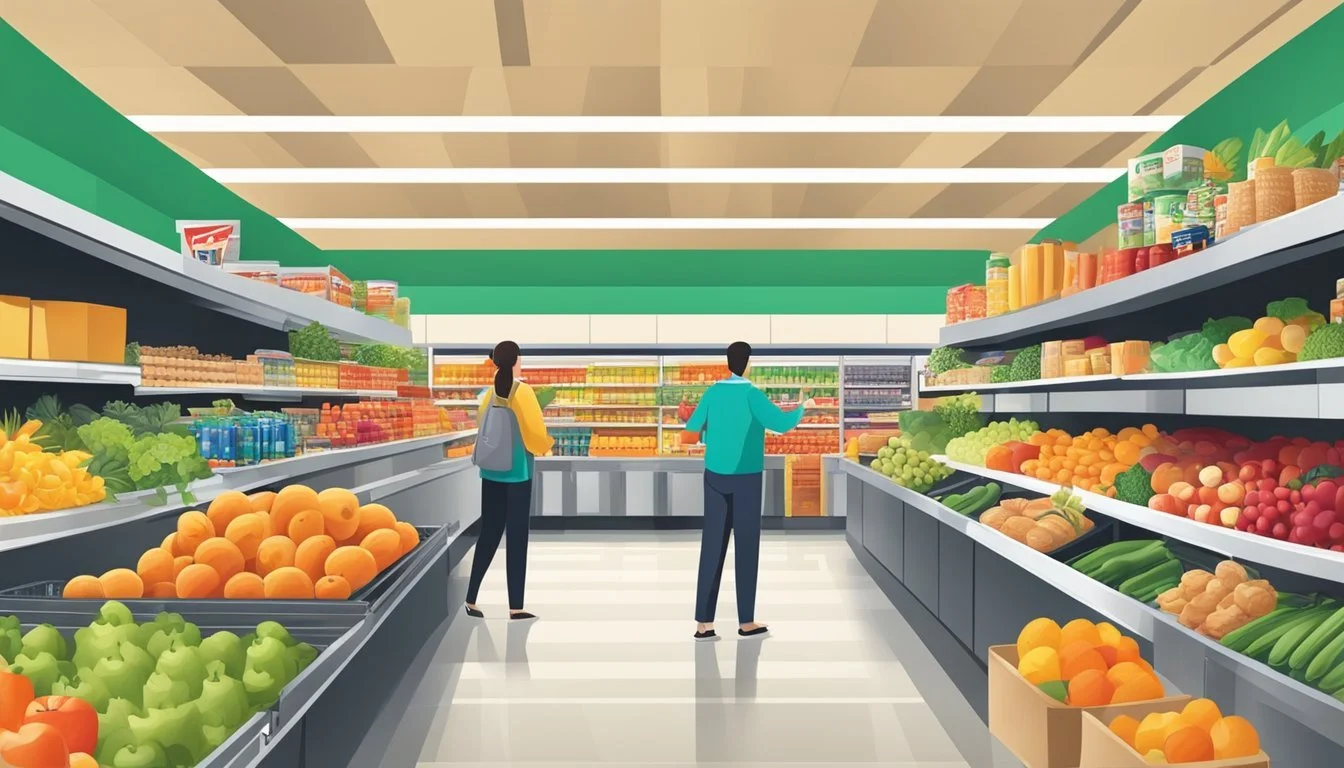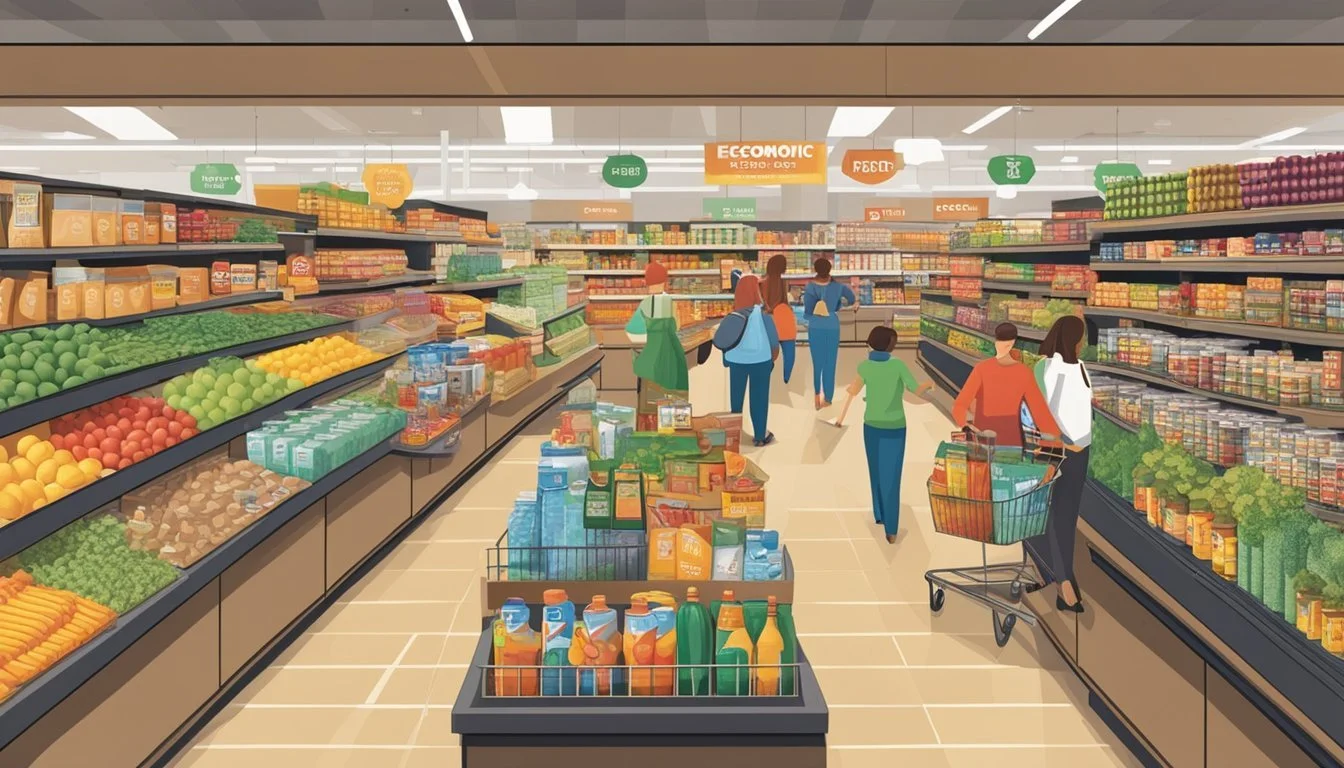Target vs H-E-B
A Comprehensive Comparison of Price, Quality, and Selection
Target and H-E-B are two popular grocery store chains that have captured the hearts of shoppers across America. While Target offers a wide range of products beyond groceries, H-E-B has built a dedicated following for its focus on quality food items and regional appeal.
H-E-B has recently gained recognition as a top grocery retailer, surpassing even well-known names like Trader Joe's and Amazon in customer preference. H-E-B's success stems from its extensive private-label offerings, competitive pricing, and strong community ties, making it a formidable competitor to national chains like Target.
Both stores have their strengths, with Target known for its trendy home goods and clothing alongside groceries, and H-E-B praised for its fresh produce and locally-sourced products. The choice between the two often comes down to individual shopping preferences and regional availability.
History and Presence
Target and H-E-B have distinct origins and growth trajectories that have shaped their current market positions. Both retailers have expanded significantly from their humble beginnings to become major players in the grocery industry.
Target's Origins and Expansion
Target traces its roots back to 1902 when George Dayton founded Goodfellow Dry Goods in Minneapolis, Minnesota. The company rebranded as Target in 1962, launching its first discount store in Roseville, Minnesota.
Target rapidly expanded across the United States in the following decades. By the 1990s, it had established a presence in major markets nationwide. The retailer entered Texas in 1975, opening stores in Dallas and Houston.
Today, Target operates over 1,800 stores across all 50 states. Its expansion into urban markets with smaller-format stores has further increased its reach.
H-E-B's Texas Roots and Growth
H-E-B's story began in 1905 when Florence Butt opened a small grocery store in Kerrville, Texas. Her son, Howard Edward Butt, took over the business in 1919 and expanded it throughout the state.
The company's name, H-E-B, comes from Howard E. Butt's initials. H-E-B focused primarily on Texas, developing deep ties with local communities. It opened stores in major Texas cities like San Antonio, Austin, and Corpus Christi.
H-E-B now operates over 380 stores, mostly in Texas. It has also expanded into Mexico. The company's Central Market concept, launched in 1994, caters to gourmet and organic food enthusiasts.
Store Brands and Products
Target and H-E-B offer distinct product selections and private label offerings. Each retailer has developed unique strategies to cater to their customers' preferences and needs.
Target's Product Selection and Private Label
Target's product lineup includes a wide array of options, from groceries to household essentials. The retailer's private label brands, such as Good & Gather and Market Pantry, provide affordable alternatives to national brands. Good & Gather focuses on quality ingredients and taste, offering organic produce and pantry staples.
Target's Up & Up brand covers household essentials and personal care items. The company has also introduced specialty lines like Favorite Day for indulgent treats and snacks. These private labels aim to provide value without compromising on quality.
H-E-B's Exclusive Brands and Local Products
H-E-B takes pride in its diverse selection of exclusive brands and locally sourced products. The retailer's private label offerings include H-E-B Organics, which features a range of certified organic produce and grocery items. Their Hill Country Fare brand provides budget-friendly options across various categories.
H-E-B's Meal Simple line offers convenient, ready-to-eat meals and meal kits. The company also emphasizes local partnerships, showcasing Texas-made products throughout their stores. This focus on regional specialties sets H-E-B apart and appeals to customers seeking authentic, locally sourced options.
H-E-B's commitment to product quality has earned them a reputation for excellence in their private label offerings.
Price Comparison
Target and H-E-B employ different pricing strategies to attract customers. Both stores offer competitive rates on groceries and household items, but their approaches to discounts and special deals vary.
Everyday Prices and Discounts
Target focuses on providing low prices across a wide range of products. Their "Expect More. Pay Less." slogan reflects this commitment to affordability. Target's private label brands, like Good & Gather and Up & Up, often come with lower price tags than national brands.
H-E-B, on the other hand, is known for its competitive pricing on fresh produce and meat. The Texas-based chain leverages its local connections to offer regional products at attractive rates. H-E-B's store brands, such as Hill Country Fare, provide budget-friendly options for shoppers.
Both retailers regularly offer discounts on select items. Target's weekly ad features numerous price cuts, while H-E-B's "Yellow Tag" specials highlight temporary price reductions throughout the store.
Special Deals and Digital Coupons
Target's Cartwheel program, integrated into its app, allows customers to access digital coupons and exclusive offers. The retailer frequently provides percentage-off discounts on specific categories or brands. Target Circle, their loyalty program, offers additional savings and personalized deals.
H-E-B's digital coupon system is accessible through their mobile app and website. Shoppers can clip coupons for both H-E-B branded and national products. The chain's "Combo Locos" promotions bundle complementary items for significant savings.
Both stores offer price matching policies, but terms may vary. Target matches prices from select online and local competitors, while H-E-B focuses on matching local print ads.
Quality and Freshness
Both Target and H-E-B prioritize quality and freshness in their grocery offerings. Their approaches differ in some key areas, impacting product selection and customer satisfaction.
Quality Assurance Practices
Target implements rigorous quality control measures for its food products. The company has strict standards for suppliers and conducts regular inspections. Target's organic offerings have expanded in recent years, with the Good & Gather brand featuring many organic options.
H-E-B is known for its commitment to quality, especially in its private label products. The company works closely with local farmers and producers to ensure high standards. H-E-B's quality assurance team regularly tests products for safety and flavor.
Freshness of Produce and Perishables
Target's produce section has improved, with efforts to source locally when possible. The company has invested in cold chain management to maintain freshness. Target's milk, eggs, and bread typically have good turnover rates, ensuring customers receive fresh products.
H-E-B excels in produce freshness, often sourcing from nearby farms. The company is known for its ripe avocados and diverse produce selection. H-E-B's bakery department produces fresh bread daily, and its dairy section offers a wide range of fresh milk and egg options.
Customer Experience and Services
Target and H-E-B offer distinct shopping experiences and services tailored to their customer bases. Both retailers prioritize convenience and satisfaction, but their approaches differ in key areas.
In-Store Shopping Experience
Target provides a bright, organized layout with wide aisles and clear signage. The store's design emphasizes a clean, modern aesthetic. Target's self-checkout options and mobile app for in-store navigation enhance convenience.
H-E-B focuses on a more personalized experience. The chain is known for its friendly staff and emphasis on local products. H-E-B stores often feature specialty departments like in-store bakeries and delis. The retailer's commitment to customer service has contributed to high satisfaction ratings.
Both chains prioritize cleanliness and product availability. Target's larger stores may offer a broader selection of non-grocery items. H-E-B excels in fresh produce and regional specialties.
Online Shopping and Delivery Services
Target has invested heavily in its digital presence. The company offers same-day delivery through Shipt and drive-up services for online orders. Target's app integrates in-store and online shopping seamlessly.
H-E-B has expanded its e-commerce options in recent years. The retailer provides curbside pickup and home delivery in many locations. H-E-B's online platform focuses on grocery essentials and fresh items.
Both chains have user-friendly websites and mobile apps. Target's broader merchandise selection gives it an edge for one-stop online shopping. H-E-B's strength lies in its grocery-focused approach and local product offerings.
Convenience and Accessibility
Target and H-E-B differ significantly in their convenience and accessibility for shoppers. Both retailers have unique strengths and limitations in their physical locations and digital offerings.
Location and Store Accessibility
Target operates over 1,800 stores across all 50 U.S. states, providing widespread accessibility. Most Target locations feature spacious parking lots and wide aisles, enhancing the shopping experience. Many stores are strategically placed in suburban areas and shopping centers, making them convenient stops for errands.
H-E-B, in contrast, has a more limited geographical presence. The chain primarily serves Texas, with over 340 stores concentrated in the Lone Star State. This regional focus allows H-E-B to tailor its offerings to local preferences but restricts accessibility for shoppers outside Texas.
Both retailers typically provide ample parking and wheelchair-accessible entrances. Target stores often include in-store Starbucks cafes, adding convenience for shoppers seeking refreshments.
Online Accessibility and E-Commerce
Target excels in e-commerce, offering a robust online shopping platform and mobile app. Customers can choose from various fulfillment options, including same-day delivery, in-store pickup, and drive-up services available at most locations nationwide.
H-E-B has made significant strides in its digital offerings, particularly in Texas. The company provides online ordering, curbside pickup, and home delivery services through its website and mobile app. H-E-B's "My H-E-B" app allows customers to create shopping lists, access digital coupons, and place orders.
Both retailers have invested in user-friendly interfaces for their online platforms. Target's broader national presence gives it an edge in online accessibility for shoppers outside Texas.
Customer Loyalty and Trust
Target and H-E-B have cultivated strong customer bases through distinct approaches to rewards, savings, and brand reputation. Both retailers prioritize customer experience and strive to build emotional connections with shoppers.
Rewards Programs and Savings
Target offers the Target Circle loyalty program, providing 1% cashback on purchases and personalized deals. Members earn points redeemable for future discounts. The Target RedCard credit or debit card provides an additional 5% off purchases.
H-E-B's loyalty program, H-E-B Points Club Rewards, allows customers to earn points on purchases. These points can be redeemed for free products or discounts. H-E-B also offers digital coupons and weekly specials through its mobile app.
Both stores frequently run sales and promotions, with Target known for its clearance deals and H-E-B for its combo loco offers on multiple items.
Brand Trust and Customer Retention
H-E-B consistently ranks high in customer loyalty surveys. Its focus on fresh, local products and community involvement fosters strong emotional connections with shoppers. The retailer's swift response during crises, such as natural disasters, has further solidified customer trust.
Target has built brand trust through its commitment to design and affordability. The company's collaborations with popular designers and its private label brands create a unique shopping experience. Target's corporate social responsibility initiatives, including sustainability efforts and community giving, contribute to its positive brand image.
Both retailers prioritize customer service, but H-E-B often receives higher marks for employee knowledge and helpfulness. Target's user-friendly website and app enhance the digital shopping experience, appealing to tech-savvy consumers.
Corporate Responsibility and Values
Target and H-E-B demonstrate strong commitments to corporate responsibility and community engagement. Both retailers prioritize sustainability initiatives and social causes, while fostering unity within the communities they serve.
Environmental and Social Initiatives
Target has set ambitious sustainability goals, aiming to reduce its carbon footprint and increase the use of renewable energy. The company pledges to achieve net-zero emissions by 2040 and sources 100% sustainable cotton for its owned brand products.
H-E-B focuses on waste reduction and energy efficiency. The Texas-based grocer implements recycling programs and utilizes energy-saving technologies in its stores. H-E-B also emphasizes responsible sourcing, partnering with local farmers and suppliers to reduce transportation emissions.
Both retailers have launched initiatives to promote diversity and inclusion within their workforces and supply chains.
Community Involvement and Unity
Target's community efforts include education support, disaster relief, and volunteer programs. The company donates 5% of its profits to local communities, totaling over $1 billion annually.
H-E-B is known for its swift response to natural disasters, providing emergency supplies and mobile kitchens during crises. The retailer's "H-E-B Helping Here" program supports local schools, food banks, and non-profit organizations.
Both companies prioritize local involvement, tailoring their community initiatives to address specific regional needs. This approach fosters a sense of unity and strengthens ties with customers in the areas they serve.
Economic Impact
Target and H-E-B both play significant roles in their respective local and state economies. Their operations create jobs, generate tax revenue, and support communities in various ways.
Effect on Local Economy and Workforce
Target employs over 400,000 people across the United States, with a substantial presence in Minnesota where its headquarters are located. The company's stores and distribution centers provide employment opportunities in many communities.
H-E-B, primarily operating in Texas, employs over 145,000 workers. As a major employer in the state, H-E-B contributes significantly to local job markets and workforce development.
Both retailers invest in employee training and development programs. These initiatives help enhance workforce skills and create career advancement opportunities within the companies.
Contribution to Texas Economy
H-E-B has a particularly strong economic impact on Texas. The company's revenue exceeded $34 billion in 2022, with most of this generated within the state.
H-E-B's extensive network of stores, distribution centers, and manufacturing facilities contributes substantially to Texas's GDP. The company's operations support numerous local suppliers and businesses.
Target, while having a national presence, also contributes to Texas's economy through its stores in the state. However, its impact is less concentrated compared to H-E-B's Texas-centric operations.
Both retailers generate significant tax revenue for Texas through sales tax and property tax on their facilities. This revenue supports various state and local government services and initiatives.
Comparison Summary
Target and H-E-B are both popular grocery retailers with distinct strengths. H-E-B consistently ranks high on the retailer preference index, particularly in Texas markets.
Customer preferences play a significant role in determining which store is better. H-E-B is known for its strong regional presence and loyal customer base in Texas.
Target offers a broader range of non-grocery items, making it a one-stop shop for many consumers. The retailer's focus on stylish, affordable home goods and clothing sets it apart.
H-E-B excels in its private label offerings, with many customers praising the quality and value of its store brand products.
Both retailers have made strides in e-commerce and curbside pickup options, adapting to changing consumer needs.
Price comparisons between the two can vary by location and product category. Target often competes well on non-grocery items, while H-E-B may have an edge in fresh produce and local products.
Store layout and shopping experience differ between the two. H-E-B stores typically have a more traditional grocery store layout, while Target integrates its grocery section into its broader retail space.
The choice between Target and H-E-B often comes down to individual shopping habits, location, and specific product needs.








